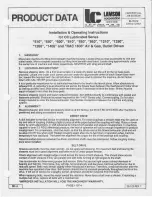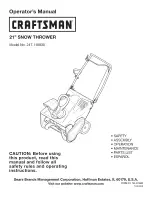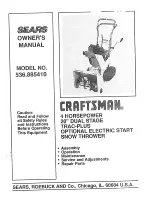
2
Always perform a test run the first time you use the snow
thrower or after replacing parts to ensure that the unit is
functioning properly.
• Preliminary area inspection –
Clear the area to be plowed
before each use. Remove all objects, such as rocks, broken
glass, nails, wire, or string, which can be thrown by or
become entangled in the snow thrower. Keep the area of
operation clear of all spectators, particularly children
and pets.
• Excessive force –
The snow thrower was designed to
respond at a certain rate for various snow conditions for
optimum safety and performance. Do not force it; keep
pressure constant.
• Malfunctioning switch –
Do not use the snow thrower
if the switch does not turn it on and off. Any electrical
appliance that cannot be controlled by the switch is not
safe to use and must be repaired.
• Hitting an object –
If the snow thrower accidentally strikes
an object, follow these steps:
i) Stop the snow thrower and unplug the unit
ii) Inspect for damage
iii) Repair or replace any damaged part before restarting
and operating the snow thrower.
•
Discharge chute safety – Never direct the snow discharge
chute at the operator, at bystanders, at vehicles, or at
windows. The discharged snow stream and foreign objects
accidentally picked up by the snow thrower can cause
serious damage and personal injury. Do not use your hands
to unclog the discharge chute. Stop the motor before
removing debris.
• Hand-held operating position –
Operation of the snow
thrower in the hand-held position is unsafe.
• Abnormal operation –
If you notice the snow thrower
running in an unstable state or hear abnormal sounds from
the engine, immediately stop the machine, disconnect the
power, and contact an authorized Snow Joe
®
+ Sun Joe
®
dealer or the Snow Joe
®
+ Sun Joe
®
customer service
center at 1-866-SNOWJOE (1-866-766-9563).
• Noise control –
When using the snow thrower, you must
respect local laws and regulations regarding noise control
and environmental protection. To avoid noise disturbance,
you should carefully decide upon an appropriate operation
time and consider the surrounding conditions.
• When work is completed –
Disconnect the snow thrower
from the power source when not in use, when changing
accessories, and before performing any maintenance
function.
• Store safely –
Store the snow thrower indoors in a dry area
between uses. Keep it in a locked area, where children and
unauthorized users cannot gain access. Do not store the
machine while it is still connected to the power source as
this may result in damage and injury.
• Maintain for safety and longevity –
Check for
misalignment or binding of moving parts, breakage of
parts, and any other conditions that may affect the unit’s
operation. If damaged, repair or replace the damaged part
before use. Use only original replacement parts designed
specifically for your model. When replacing any parts,
you must strictly observe the instructions and procedures
described in this manual. Special care should be paid to
any rubber parts, since these parts may increase the engine
load and decrease its mechanical power if damaged.
Always check that all bolts, nuts, and knobs are tight before
using the snow thrower!
Electrical Safety
1. Electrical plugs must match the outlet. Never modify
the plug in any way. Do not use any adapter plugs with
grounded appliances. Unmodified plugs and matching
outlets will reduce the risk of electric shock.
2. Avoid body contact with earthed or grounded surfaces
(i.e. upper and lower water pipes, radiators, ranges,
refrigerators, microwave ovens, and outer frames of
heating equipment). Take necessary precautions to avoid
electric shock. There is an increased risk of electric shock
if your body is earthed or grounded.
3. Do not abuse the cord. Keep cord away from heat,
oil, sharp edges, or moving parts. Never carry the snow
thrower by its cord or yank the cord to disconnect it from
the electrical outlet. Damaged or entangled cords increase
the risk of electric shock.
4. Replace or properly repair damaged cords. If the cord
becomes damaged in any manner while plugged into the
wall receptacle, immediately pull the extension cord plug
from the receptacle.
5. Contact with water while operating the snow thrower
can result in electric shock and serious bodily injury.
Do not use the snow thrower in damp or wet locations or
expose to rain. Do not handle the plug or the appliance
with wet hands or while standing in water.
6.
m
WARNING – Only use a UL-rated extension cord for
OUTDOOR, all-weather use. To prevent the extension
cord from disconnecting during operation, refer to Fig. 12
(p. 8).
7. Turn off the power switch and disconnect the power
cable before making any adjustments to the unit and
before inspecting, servicing, changing accessories,
or cleaning the snow thrower. Follow the same
procedure if any other dangerous conditions present
during operation. Any adjustments to the unit should be
performed after revolving parts inside the snow thrower
stop completely. Such preventative safety measures
reduce the risk of starting the power tool accidentally.
8. If you find the main power cable or the extension cable
damaged, please pull out the plug from the socket and
disconnect the power immediately. Repair the cable or
replace it if necessary.


































